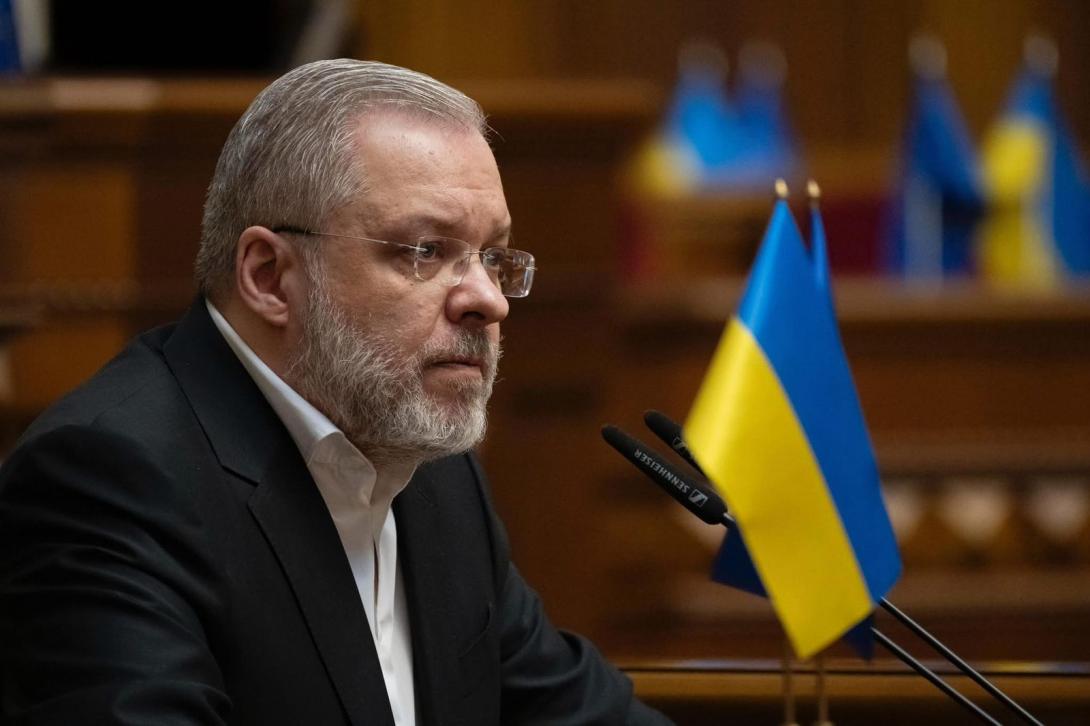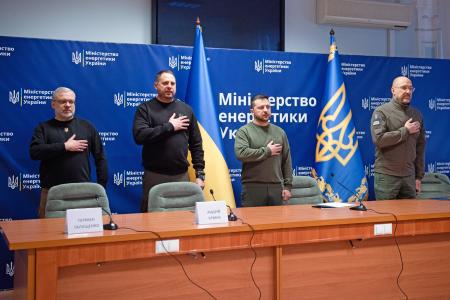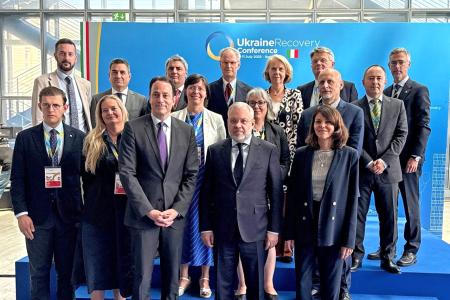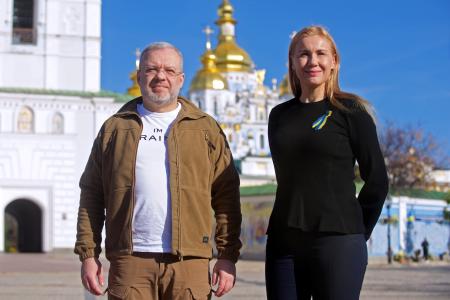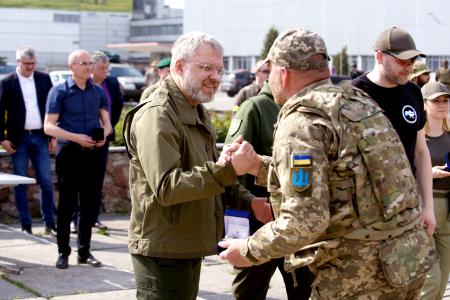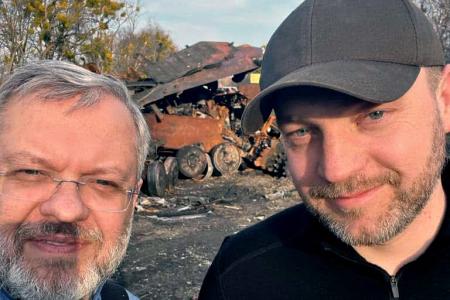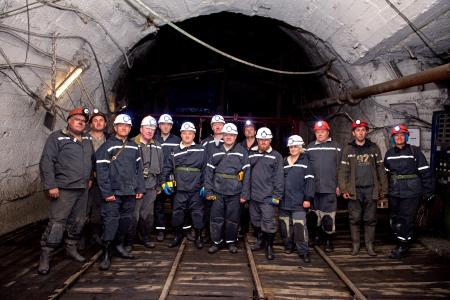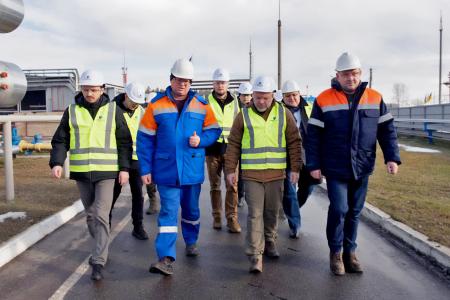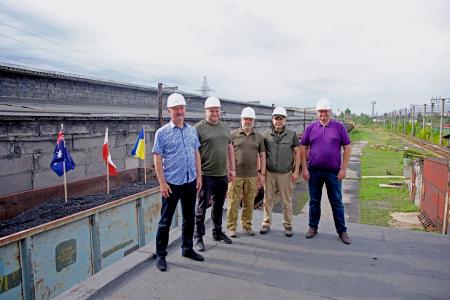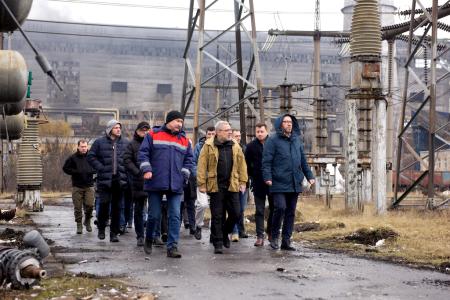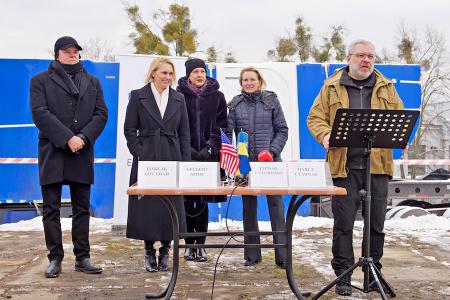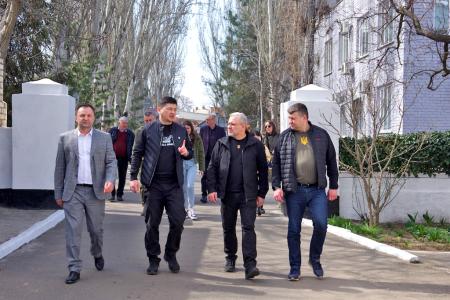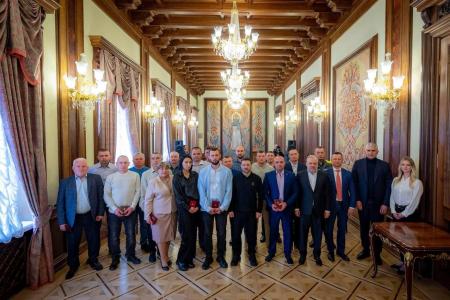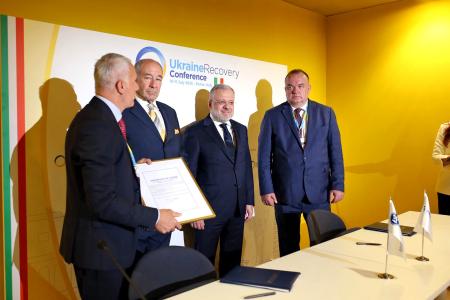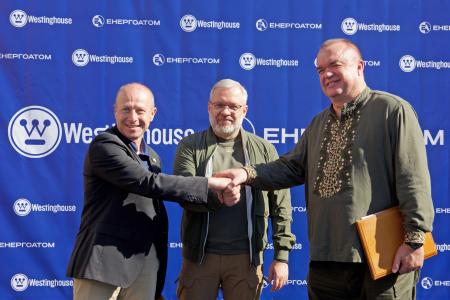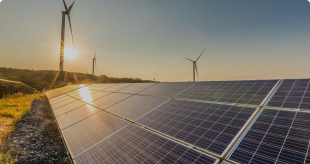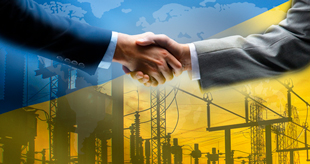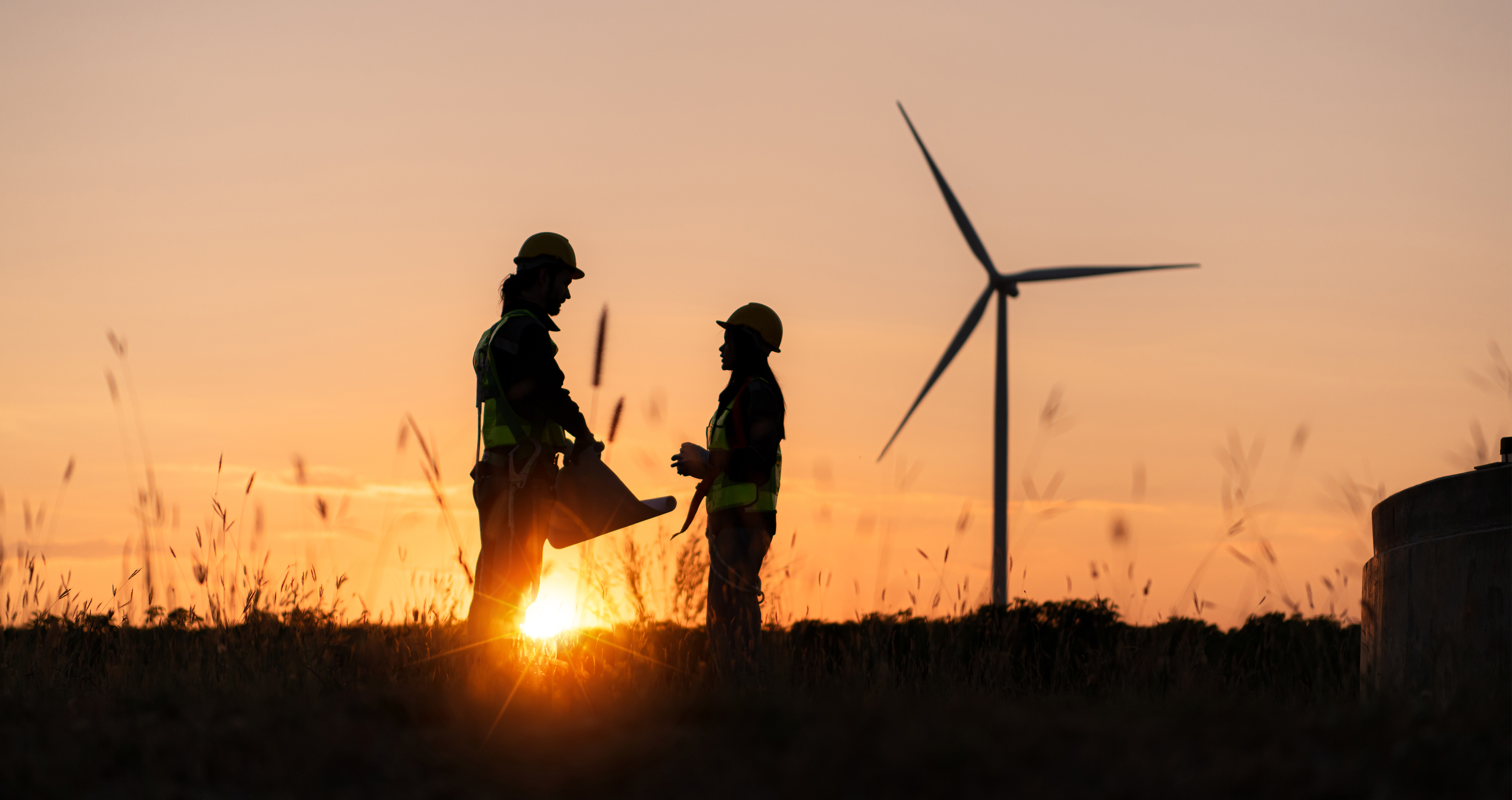For more than four years, I have had the honor of leading the Ministry of Energy of Ukraine.
These have been, without exaggeration, the most difficult times for the energy sector. Since the beginning of the full-scale invasion by the Russian Federation, more than 50% of the capacities that existed before the invasion have been destroyed, damaged, or occupied. Since 2022, the Zaporizhzhia Nuclear Power Plant and five thermal power plants have been occupied. The Kakhovka Hydroelectric Power Plant has been destroyed. These are unprecedented losses for the 21st-century world.
But we did everything possible to prevent the worst-case scenarios from becoming a reality. We held out and maintained the energy front.
Since the first days of the full-scale invasion, the leadership of the Ministry has remained at their workplaces, working from Kyiv and staying in constant, round-the-clock contact with the regions.
Thanks to our joint efforts, Ukrainians have light and heat in their homes. Now, even during peak demand in the summer heat, consumers are not experiencing any outages.
This is the result of the tireless, round-the-clock efforts of thousands of workers across the entire energy sector of the country!
Most importantly:
We are not only restoring what has been destroyed — we are laying the strategic foundation for a European energy future free from dependence on Russian resources.
Today, our position on the complete rejection of Russian energy resources has become a cornerstone of energy policy. This is an important signal for Ukraine on its path toward becoming a member of the European Union.
ELECTRICITY SECTOR
For the first time in the history of Ukraine, we have achieved true energy independence from the aggressor country — Russia.
In fact, Russia declared an energy war on us back in the autumn of 2021, when, without warning, it blocked coal supplies to Ukraine’s thermal power plants. The disruption of coal deliveries from Russia posed an energy challenge and threatened to derail the passage of the 2021–2022 heating season.
The situation was further complicated by a sharp rise in global coal and natural gas prices and the need to compensate for decreased generation at thermal power plants (due to record-high natural gas prices). But we managed to quickly adapt and reconfigure our logistics: contracts were urgently signed with alternative suppliers, and fuel import channels by sea were established. Coal began arriving through Black Sea ports. In January and February 2022, 650,000 tonnes of energy coal were delivered to Ukraine.
This was an invaluable experience ahead of the full-scale invasion in 2022, when the issue of energy independence became critical.
On the very first day of the full-scale war, we disconnected from the energy system of Russia and Belarus, and 21 days later, we joined the European network ENTSO-E.
For 21 days, the system operated in isolated mode, preparation for which had been ongoing since 2021. Tremendous work was done to carry out two planned "isolations" in the winter and summer. But with the start of the full-scale invasion, the disconnection from the Russian and Belarusian systems became key to ensuring energy independence and helped maintain the power system during Russian attacks.
At the same time, during wartime, we managed to establish the possibility of importing and exporting electricity with the EU. Currently, import capacity has been increased to 1.7 GW, and export — to 900 MW. Ukraine has already been operating as part of ENTSO-E for more than 1,000 days.
In 2023, the most extensive repair campaign in the history of Ukraine was carried out at energy facilities. In less than a year, we prepared about 16 GW of capacity for the heating season, including the restoration and addition of 2.2 GW to the energy system in thermal and hydro generation. Thanks to international support and coordination between energy companies and the government, we managed to avoid prolonged blackouts and stabilize the operation of the energy system under conditions of military aggression.
In 2024, after 13 massive missile and drone attacks, 4 GW of capacity were restored. During 2025, another 2.2 GW of generating capacity have been restored. The plan is to bring this figure up to 3.7 GW by the end of 2025.
The energy system is being continuously restored from the consequences of military aggression. Currently, operating modes are balanced, and there is no deficit in the energy system. Electricity is being exported and imported with the neighboring energy systems of European Union countries.
RENAISSANCE OF NUCLEAR ENERGY
Nuclear energy is fundamental for Ukraine. Understanding this, the enemy tried to deprive us of nuclear power plants by occupying the Chornobyl and Zaporizhzhia nuclear plants. The Zaporizhzhia plant remains under Russian occupation.
But despite everything, we were able to ensure nuclear safety for Europe and prevent a global-scale catastrophe. As a result of close cooperation with the IAEA, it became possible for Agency experts to remain permanently at the occupied Zaporizhzhia NPP site, as well as at Ukraine’s operating nuclear power plants to monitor nuclear and radiation safety.
Ukraine was elected a member of the IAEA Board of Governors for the 2023–2025 period.
Nearly 50 partner countries issued two joint statements in support of Ukraine's territorial integrity and independence, demanding that the Russian Federation withdraw from the illegally occupied Zaporizhzhia NPP. A similar joint statement was made during the IAEA ICONS-2023 international conference.
During its membership, Ukraine initiated three important resolutions on the impact of unstable energy infrastructure on the safety of nuclear power plants. These resolutions were adopted by the Board of Governors and are binding on all IAEA member states.
At the 2025 Recovery Conference in Rome, support and further cooperation with the IAEA were strengthened, and an important Memorandum was signed providing for safety guarantees during the completion of the Khmelnytskyi NPP power units.
Even before the start of the full-scale war, together with HOLTEC INTERNATIONAL, Ukraine built the world’s only unique Centralized Spent Nuclear Fuel Storage Facility (CSFSF).
! Using this domestic storage facility saves Ukraine about USD 200 million annually. Most importantly, it allowed Ukraine to stop sending spent nuclear fuel to Russia even before the war began. This is a strategic breakthrough for Ukraine — saving significant funds, enhancing energy independence and security. Additionally, we gained new industrial potential for the localization of critical nuclear equipment production.
A week ago in Rome, an important Memorandum was signed with Holtec on the development of modern production facilities for the manufacture of nuclear components and spent nuclear fuel storage systems. Moreover, it is planned to deploy Holtec’s SMR-300 small modular reactors in Ukraine. The first stage of the project was the signing in 2023 of a framework agreement to implement the national strategy for the transition to small modular nuclear generation through active cooperation with Holtec and localization of nuclear equipment production in Ukraine. Currently, capacity building and technical training involving Ukrainian specialists in the SMR-300 program at Palisades NPP in the United States is underway.
Ukraine has fully transitioned to non-Russian nuclear fuel, spare parts, and services. The groundwork has been laid for nuclear fuel production in Ukraine that will enable the operation of 35 nuclear reactors across Europe.
In particular, last week in Rome, a declaration of intent was signed with Westinghouse to build fuel assembly production in Ukraine for Soviet-type reactors. This will give European countries the ability to abandon Russian nuclear fuel in 2027. We have expanded cooperation and are implementing joint projects with the world’s largest companies — GE, Baker Hughes, EDF, and many others.
In 2023, Westinghouse, with the participation of our Energoatom specialists, produced nuclear fuel for VVER-440 type reactors. This is a major achievement that breaks Russia’s monopoly on the market and enables a transition away from fuel produced by the terrorist state.
In November 2024, Ukraine and the United States officially announced the launch of three cooperation projects under the FIRST Program to implement advanced nuclear energy technologies — small modular reactors (SMRs). Currently, the first two projects are being successfully implemented with financial support from the U.S. Department of State.
Cooperation has been strengthened in the field of nuclear and radiation safety with G7 countries under the Global Partnership Initiative and the Information Sharing Initiative (ISI).
Support has also been attracted for building human resource capacity in the nuclear sector from the OECD/NEA and enhanced cooperation with the Nordic group of countries, among others.
GAS SECTOR
On January 1, 2025, Ukraine terminated the transit of Russian gas. We certified our underground gas storage facilities in accordance with EU regulations. This enabled their use for foreign supplies — nearly 3 billion cubic meters in 2023–2024 stored in Ukraine confirms international trust.
Despite constant enemy shelling of gas production facilities, we managed to avoid shortages and increased import capacities by expanding routes. In particular, the capacity for guaranteed imports from the Polish direction was increased, which also allows the delivery of gas to Ukraine from the Baltic Pipe and for receiving natural gas from Norway and LNG terminals. The Trans-Balkan corridor was launched, through which gas from LNG terminals in Greek ports will enter Ukraine. This significantly strengthens the position of Eastern European countries in their intention to completely abandon Russian energy sources by 2027.
We established a legal framework and launched exports of biomethane to the European Union.
RENEWABLE ENERGY AND DISTRIBUTED GENERATION
On the initiative of the Ministry of Energy, a number of documents were developed to promote the development of renewable energy and distributed generation. In particular:
* In 2023, the Verkhovna Rada adopted Law No. 3220-IX, which establishes competitive and market-based conditions for the development of renewable energy. In addition, the mechanism of corporate PPAs was introduced, a system of guarantees of origin for green electricity was launched, and the approach to conducting “green” auctions was updated.
* In 2024, the Strategy for the Development of Distributed Generation until 2035 and the National Action Plan for the Development of Renewable Energy until 2030 were approved. The plan defined the strategic goal — a 27% share of renewables in the energy balance — and the paths to achieve it in accordance with Ukraine’s commitments to the EU.
* Conditions were created for attracting investment in renewable energy on the consumer side, in particular through the self-generation model — Net Billing. As a result, over 100 MW of new capacity of active consumers has appeared in Ukraine. In 2022, the Ministry of Energy developed the Concept for the Implementation of Smart Grids in Ukraine until 2035. In 2024, the National Energy and Climate Plan until 2030 was approved, which aligns with the EU’s goals on decarbonization and sustainable energy development. Over 1 GW of distributed generation facilities have been connected to the grid.
* In April 2023, upon the submission of the Ministry of Energy, the Cabinet of Ministers of Ukraine approved the Energy Strategy of Ukraine until 2050.
* Energy resilience passports of the regions have been developed.
* Financial programs have been launched to enhance consumers’ energy independence: preferential 0% loans for the purchase of energy equipment, the “Affordable Loans 5-7-9” program, and the “GreenHome” program.
* Projects totaling UAH 8.3 billion have already been financed, which will provide 430 MW of new capacity.
COAL INDUSTRY
The Ministry has developed a reform concept that includes effective optimization of the mine fund structure, achieving profitability, and eventual privatization by 2028.
Importantly, for the first time in many years, the operating enterprises of the coal industry have no wage arrears to their employees.
INTERNATIONAL HUMANITARIAN SUPPORT
In April 2022, together with then-European Commissioner for Energy Kadri Simson, the Energy Support Fund was created as an effective and transparent mechanism that helped prevent prolonged blackouts. Over the years of its existence, the Fund has attracted EUR 1.16 billion, with an additional EUR 200 million expected in the near future. This Fund is not only a source of financing but also a symbol of trust and solidarity of the international community with Ukraine.
In addition, under the coordination of the Ministry of Energy, Ukraine has received nearly 1,900 humanitarian shipments since March 2022. More than 24,000 tonnes of energy aid have come from 38 countries. This equipment was transferred to energy companies for emergency repairs, which allowed the restoration of more than 5 GW of generation capacity.
HARMONIZATION WITH THE EU
The energy sector is one of the leading areas in the process of harmonization with European Union law. This was confirmed during the screening sessions held on July 8–9 this year in Brussels.
In 2022, Ukraine chaired the Energy Community, demonstrating leadership in implementing European approaches to energy market regulation.
The adopted laws created conditions for direct consumer participation in the market, the development of green generation, and integration into the EU's internal electricity market.
REFORMS AND DE-OLIGARCHIZATION
During the war, Ukraine implemented a number of decisive steps to de-oligarchize the energy sector. Twenty-seven gas distribution companies were returned under the state control, and seven regional power supply companies (Oblenergos), previously owned by Russian oligarchs, were nationalized.
According to the decision of the Cabinet of Ministers, a joint-stock company was established to ensure electricity distribution in seven regions, including four frontline regions. This allowed for the restoration of control over critical infrastructure, ensuring actual management of state-owned shares and the effective modernization of infrastructure.
At the same time, the ownership structure of the Gas Transmission System Operator of Ukraine was optimized, and the corporatization of the state enterprise "Energoatom" was carried out. Independent supervisory boards were established in state energy companies in accordance with the OECD’s guidelines on sound corporate governance.
PROTECTION OF CRITICAL INFRASTRUCTURE
Throughout the years of the full-scale invasion, taking into account the challenges of wartime, the Ministry of Energy has been working on building a system of enhanced protection of the energy infrastructure — from cybersecurity to multi-level physical protection of facilities.
Ukraine is the number one country in Europe in terms of the number of cyberattacks it faces. A telling figure — since 2022, 470 complex, multi-vector cyberattacks on the energy sector have been recorded. And the fact that the system continues to operate uninterruptedly is the most important result.
As for physical protection: over 900 facilities have been included in the list of critical infrastructure of the fuel and energy sector. In cooperation with the security and defense forces of Ukraine, a system of protection of energy facilities, which significantly minimizes damage from Russian attacks, has been organized.
We will be able to talk about the details of our work in the field of defense after the Victory.
SUPPORT FOR THE ARMED FORCES OF UKRAINE
Since the beginning of the full-scale invasion, the country’s state-owned energy companies have allocated over 17 billion hryvnias to meet the needs of the Armed Forces of Ukraine. With these funds, combat units have been provided with the necessary equipment, machinery, electronic warfare systems, and more.
Heartfelt gratitude:
To the energy workers of Ukraine. Only you know the true price of light and warmth in every home, when Ukrainian energy infrastructure has been one of Russia’s primary targets for the fourth consecutive year. Truly titanic work stands behind this. Brave and professional, restoring and repairing substations, power lines, transformers, and gas connections day after day. You are the true heroes: electricians, lineworkers, engineers, power unit operators, technicians, and many others from every region of Ukraine. The work of each and every one of you is one of the key elements of our defense! Special thanks to the company leaders for your leadership, responsibility, and resilience!
To all international partners. Thank you for ensuring Ukraine did not face energy challenges alone. The whole world stood in support of protecting energy independence: the countries of Europe, the United Kingdom, the United States. Every one of your contributions is light in the homes of Ukrainians! We created a true international coalition that helped Ukraine withstand attacks that no other European country has faced in modern history. And now we have experience that is already working in the form of real contracts, concrete support, trust, and assistance!
To the team of the Office of the President, the Verkhovna Rada, fellow government officials, regional administrations, and territorial communities — thank you for your joint efforts, consolidated actions, and shared results!
I personally thank the President of Ukraine for his trust, for the opportunity to work as part of the team, and for his support!
It is important that the strategic decisions adopted and the launched projects will be continued. The Ministry will be headed by a person with substantial experience in the energy sector and international cooperation, who held a leadership position during the most critical times — Svitlana Hrynchuk. Best of luck!
We stood firm. And we move forward — stronger, more experienced, and more united than ever.

